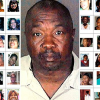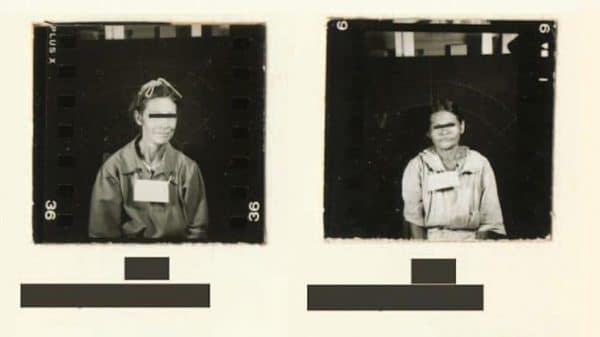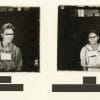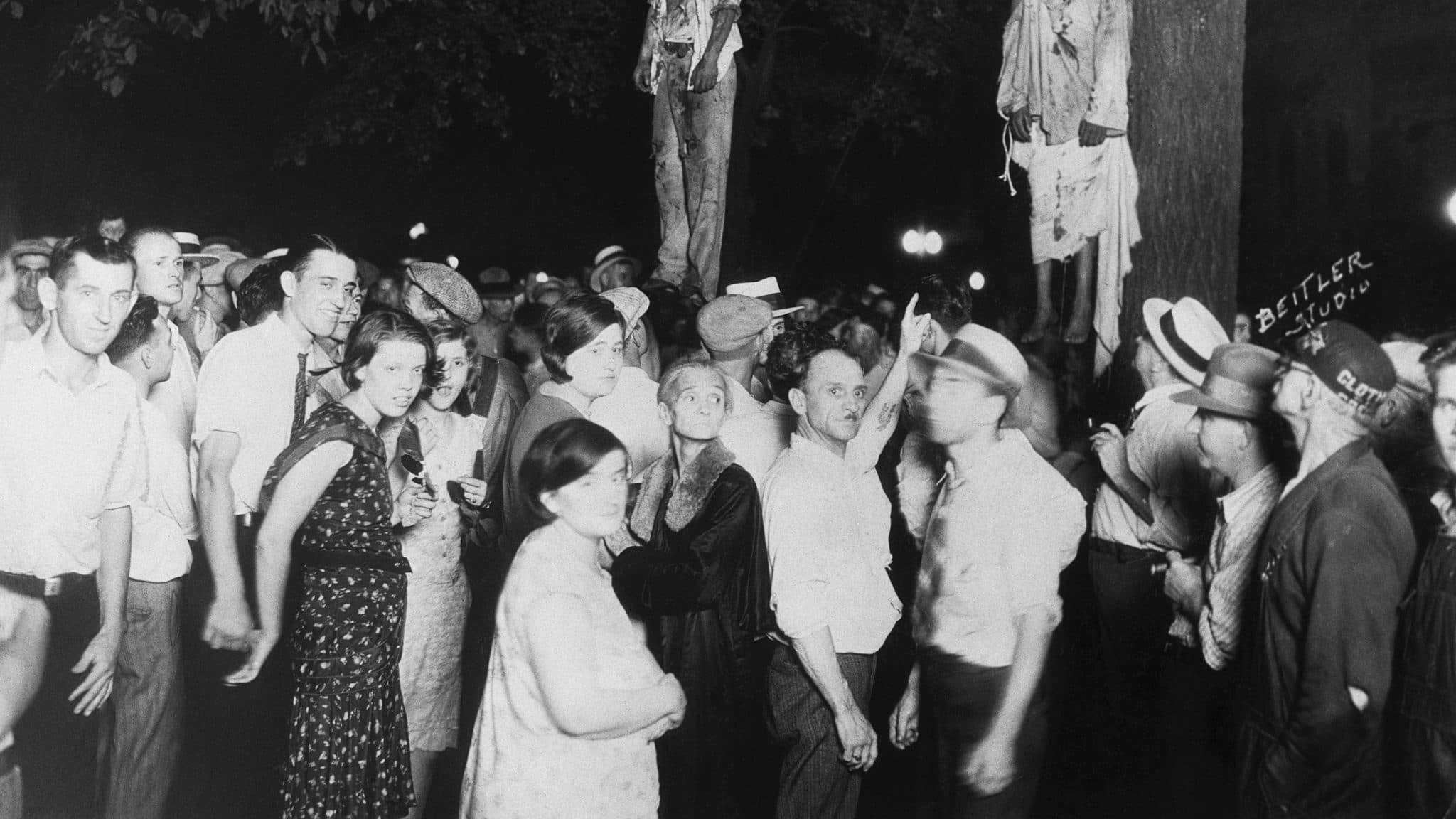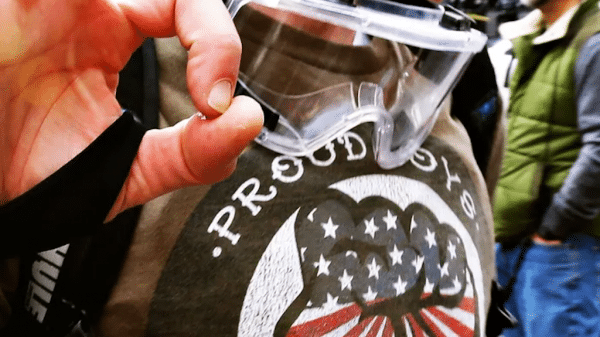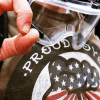via Flashbak
Even after the abolition of slavery in 1865, America’s blacks were trapped.
Nothing was equal. Whites had. Blacks had not.
No more vivid picture of the murderous racism that lay in the USA’s heart is there than blacks being lynched by white mobs.
These were no secret killings. Sometimes thousands would turn up to watch the murders.
These were not neat executions. The black victim was routinely tortured, kept alive until the body could stand no more.
Murder was celebrated in postcards. These were ‘I was there’ moments.
Postcard depicting the lynching of Lige Daniels, Center, Texas, USA, August 3, 1920. The back reads: “This was made in the court yard in Center, Texas. He is a 16 year old Black boy. He killed Earl’s grandma. She was Florence’s mother. Give this to Bud. From Aunt Myrtle.”
Should we couch these crimes in their time? Not all victims of summary justice were black. The perpetrators were, however, always white:
…in 1933 in San Jose, Calif., such an act of violence drew applause from the state’s highest officials. In fact, to hear the governor talk about it, he’d have pinned medals on the chest of each and every member of the bloodthirsty mob, if anyone had made much of an effort to find them.
The case was the murder of Brooke Hart, the handsome, affable 22-year-old scion of a department-store empire. It was the depths of the Great Depression; Hart had money, others did not. And that made him a target.
Hart’s workday on Thursday, Nov. 9, 1933, had been routine. At around 6 p.m. he left the store that was owned by his millionaire father, and picked up his green Studebaker from a nearby garage. The night was going to be a busy one. First, he was to drive his father, Alex Hart, 64, to a Chamber of Commerce meeting, and then he was to drop his sister, Aleese, 18, off at home. By 6:30, he was expected at a public speaking lesson.
He never showed up.
Nearly four hours after Brooke’s disappearance, the phone rang at the Hart mansion. A male voice said that Hart was safe, demanded a $40,000 (roughly $660,000 today) ransom, and warned the family to keep the police out of it. But it was too late for secrecy.
Search parties, including dozens of his father’s employees, fanned out all over the county.
By the following day a clue had emerged; Hart’s Studebaker roadster, abandoned with its lights on, was spotted on the road between San Jose and Oakland.
Three days later, a ransom note arrived. It warned that “one more peep to police” would mean death for Brooke.
Two white men were arrested:
After a night of questioning, the suspect revealed his name, Thomas Thurmond, identified his accomplice, John Holmes, and offered an account of the horrifying last scene of his victim’s life.
Thurmond and Holmes, an unemployed oil worker, friends for about a year, had hatched the kidnapping scheme about six weeks earlier. On the evening of Nov. 9, as Hart steered his roadster out of the driveway to the garage, Holmes flagged him down, then pointed a gun at the driver and forced his way into the car. Thurmond was following behind in Holmes’ car.
Holmes drove Hart about 7 miles from San Jose, where they abandoned the Studebaker, transferred their captive to the second car, and drove to the San Mateo bridge. Holmes ordered Hart to get out of the car, and hit him over the head with a brick. The pair bound the stunned man’s arms and legs with bailing wire, weighted him down with concrete blocks, and tossed him into the bay…
A mob, estimated to be about 5,000 strong, clogged the streets before the jailhouse. Police fired tear gas but it just made the mob madder, as a group of men battered down the jailhouse door with a steel pipe and trampled the sheriff. They quickly found Thurmond and Holmes, dragged the prisoners across the street to St. James Park, and hanged them from the nearest tree, to wild cheers. Some people milled about for hours, snatching grisly souvenirs.
“The mob seemed to be insane,” one officer told The Associated Press. “The tear gas never fazed them.”
It was an act of savage mass hysteria, no one could deny that, but even more shocking was the response from California Gov. James Rolph.
He called the lynching “a fine lesson to the whole nation.”
“They’ll learn that they can’t kidnap in this state,” Rolph said in a statement. “If anyone is arrested for the good job, I’ll pardon them all.”
Lynching were a part of the US way of life, as Robert L. Zangrando writes:
Vigilantism, or summary justice, has a long history, but the term lynch law originated during the American Revolution with Col. Charles Lynch and his Virginia associates, who responded to unsettled times by making their own rules for confronting Tories and criminal elements. “Lynching” found an easy acceptance as the nation expanded. Raw frontier conditions encouraged swift punishment for real, imagined, or anticipated criminal behavior. Historically, social control has been an essential aspect of mob rule.
Opponents of slavery in pre-Civil War America and cattle rustlers, gamblers, horse thieves, and other “desperadoes” in the South and Old West were nineteenth-century targets. From the 1880s onward, however, mob violence increasingly reflected white America’s contempt for various racial, ethnic, and cultural groups. African-Americans especially, and sometimes Native Americans, Latinos, Jews, Asian immigrants, and European newcomers, felt the mob’s fury. In an era when racist theories prompted “true Americans” to assert their imagined superiority through imperialist ventures, mob violence became the domestic means of asserting white dominance. Occasionally, this complemented the profit motive, when the lynching of a successful black farmer or immigrant merchant opened new economic opportunities for local whites and simultaneously reaffirmed everyone’s “place” in the social hierarchy. Sometimes lynching was aimed at unpopular ideas: labor union organizers, political radicals, critics of America’s role in World War I, and civil rights advocates were targets.
African-Americans suffered grievously under lynch law. With the close of Reconstruction in the late 1870s, southern whites were determined to end northern and black participation in the region’s affairs, and northerners exhibited a growing indifference toward the civil rights of black Americans. Taking its cue from this intersectional white harmony, the federal government abandoned its oversight of constitutional protections. Southern and border states responded with the Jim Crow laws of the 1890s, and white mobs flourished. With blacks barred from voting, public office, and jury service, officials felt no obligation to respect minority interests or safeguard minority lives. In addition to lynchings of individuals, dozens of race riots–with blacks as victims–scarred the national landscape from Wilmington, North Carolina, in 1898 to Tulsa, Oklahoma, in 1921.
Between 1882 (when reliable statistics were first collected) and 1968 (when the classic forms of lynching had disappeared), 4,743 persons died of lynching, 3,446 of them black men and women. Mississippi (539 black victims, 42 white) led this grim parade of death, followed by Georgia (492, 39), Texas (352, 141), Louisiana (335, 56), and Alabama (299, 48). From 1882 to 1901, the annual number nationally usually exceeded 100; 1892 had a record 230 deaths (161 black, 69 white). Although lynchings declined somewhat in the twentieth century, there were still 97 in 1908 (89 black, 8 white), 83 in the racially troubled postwar year of 1919 (76, 7, plus some 25 race riots), 30 in 1926 (23, 7), and 28 in 1933 (24, 4).
Statistics do not tell the entire story, however. These were recorded lynchings; others were never reported beyond the community involved. Furthermore, mobs used especially sadistic tactics when blacks were the prime targets. By the 1890s lynchers increasingly employed burning, torture, and dismemberment to prolong suffering and excite a “festive atmosphere” among the killers and onlookers. White families brought small children to watch, newspapers sometimes carried advance notices, railroad agents sold excursion tickets to announced lynching sites, and mobs cut off black victims’ fingers, toes, ears, or genitalia as souvenirs. Nor was it necessarily the handiwork of a local rabble; not infrequently, the mob was encouraged or led by people prominent in the area’s political and business circles. Lynching had become a ritual of interracial social control and recreation rather than simply a punishment for crime.
So. What could get you lynched?
Answer: whatever the whites decided.
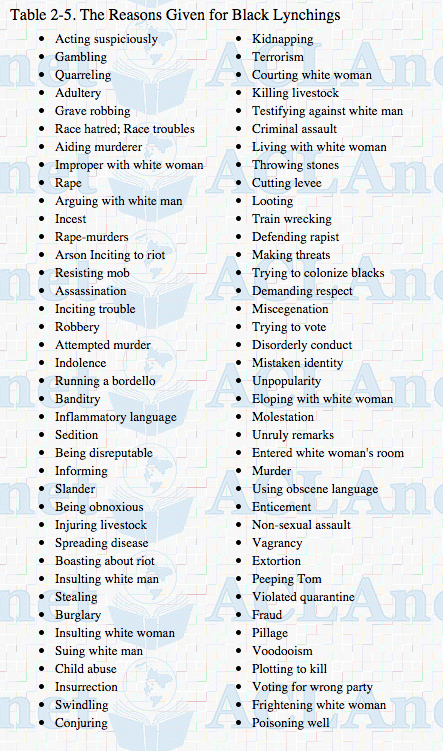
The photos here under are occasionally brutal. They show the horror we should not flinch from showing and vowing not to forget.
They show the innocent, like Emmett Till.
In the summer of 1955, the 14-year-old Till was far from home when his life ended in a most violent way, apparently for whistling at a white woman.
Dragged from his bed at his uncle’s home in a small Mississippi town, he was beaten so badly that his face was unrecognisable when the corpse was recovered from the river three days later. He had been shot in the head and his body tied to a 70lb (32kg) fan.
The two men known locally to have carried out the attack were acquitted of murder. The following year, they admitted responsibility in a magazine interview, but said they had done nothing wrong.
Till was the first martyr of the movement and he became the face of it.
Till’s killers Roy Bryant and J. W. Milam confessed to the crime in a 1956 edition of Look magazine:
Editors Note: In the long history of man’s inhumanity to man, racial conflict has produced some of the most horrible examples of brutality. The recent slaying of Emmett Till in Mississippi is a case in point. The editors of Look are convinced that they are presenting here, for the first time, the real story of that killing — the story no jury heard and no newspaper reader saw.
Disclosed here is the true account of the slaying in Mississippi of a Negro youth named Emmett Till.
Last September in Sumner, Miss., a petit jury found the youth’s admitted abductors not guilty of murder. In November, in Greenwood, a grand jury declined to indict them for kidnapping.
Of the murder trial, the Memphis Commercial Appeal said: “Evidence necessary for convicting on a murder charge was lacking.” But with truth absent, hypocrisy and myth have flourished. Now, hypocrisy can be exposed; myth dispelled. Here are the facts.
Carolyn Holloway Bryant is 21, five feet tall, weighs 103 pounds. An Irish girl, with black hair and black eyes, she is a small farmer’s daughter who, at 17, quit high school at Indianola, Miss., to marry a soldier, Roy Bryant, then 20, now 24.The couple have two boys, three and two; and they operate a store at a dusty crossroads called Money: post office, filling station and three stores clustered around a school and a gin, and set in the vast, lonely cotton patch that is the Mississippi Delta.
Carolyn and Roy Bryant are poor: no car, no TV. They live in the back of the store which Roy’s brothers helped set up when he got out of the 82nd Airborne in 1953. They sell “snuff-and-fatback” to Negro field hands on credit: and they earn little because, for one reason, the government has been giving the Negroes food they formerly bought.
Carolyn and Roy Bryant’s social life is visits to their families, to the Baptist church, and, whenever they can borrow a car, to a drive-in, with the kids sleeping in the back seat. They call Shane the best picture they ever saw.
For extra money, Carolyn tends store when Roy works outside — like truck driving for a brother. And he has many brothers. His mother had two husbands, 11 children. The first five — all boys — were “Milam children”; the next six — three boys, three girls — were “Bryant children.”
This is a lusty and devoted clan. They work, fight, vote and play as a family. The “half” in their fraternity is forgotten. For years, they have operated a chain of cottonfield stores, as well as trucks and mechanical cotton pickers. In relation to the Negroes, they are somewhat like white traders in portions of Africa today; and they are determined to resist the revolt of colored men against white rule.
On Wednesday evening, August 24, 1955, Roy was in Texas, on a brother’s truck. He had carted shrimp from New Orleans to San Antonio, proceeded to Brownsville. Carolyn was alone in the store. But back in the living quarters was her sister-in-law Juanita Milam, 27, with her two small sons and Carolyn’s two. The store was kept open till 9 on week nights, 11 on Saturday.
When her husband was away, Carolyn Bryant never slept in the store, never stayed there alone after dark. Moreover, in the Delta, no white woman ever travels country roads after dark unattended by a man.
This meant that during Roy’s absences — particularly since he had no car — there was family inconvenience. Each afternoon, a sister-in-law arrived to stay with Carolyn until closing time. Then, the two women, with their children, waited for a brother-in-law to convoy them to his home. Next morning, the sister-in-law drove Carolyn back.
Juanita Milam had driven from her home in Glendora. She had parked in front of the store to the left; and under the front seat of this car was Roy Bryant’s pistol, a .38 Colt automatic. Carolyn knew it was there. After 9, Juanita’s husband, J. W. Milam, would arrive in his pickup to shepherd them to his home for the night.About 7:30 pm, eight young Negroes — seven boys and a girl — in a ’46 Ford had stopped outside. They included sons, grandsons and a nephew of Moses (Preacher) Wright, 64, a ‘cropper. They were between 13 and 19 years old. Four were natives of the Delta and others, including the nephew, Emmett (Bobo) Till, were visiting from the Chicago area.
Bobo Till was 14 years old: born on July 25, 1941. He was stocky, muscular, weighing about 160, five feet four or five. Preacher later testified: “He looked like a man.”Bobo’s party joined a dozen other young Negroes, including two other girls, in front of the store. Bryant had built checkerboards there. Some were playing checkers, others were wrestling and “kiddin’ about girls.” Bobo bragged about his white girl. He showed the boys a picture of a white girl in his wallet; and to their jeers of disbelief, he boasted of success with her.
“You talkin’ mighty big, Bo,” one youth said. “There’s a pretty little white woman in the store. Since you know how to handle white girls, let’s see you go in and get a date with her?”
“You ain’t chicken, are yuh, Bo?” another youth taunted him.
Bobo had to fire or fall back. He entered the store, alone, stopped at the candy case. Carolyn was behind the counter; Bobo in front. He asked for two cents’ worth of bubble gum. She handed it to him. He squeezed her hand and said: “How about a date, baby?”
She jerked away and started for Juanita Milam. At the break between counters, Bobo jumped in front of her, perhaps caught her at the waist, and said: “You needn’t be afraid o’ me, Baby. I been with white girls before.”
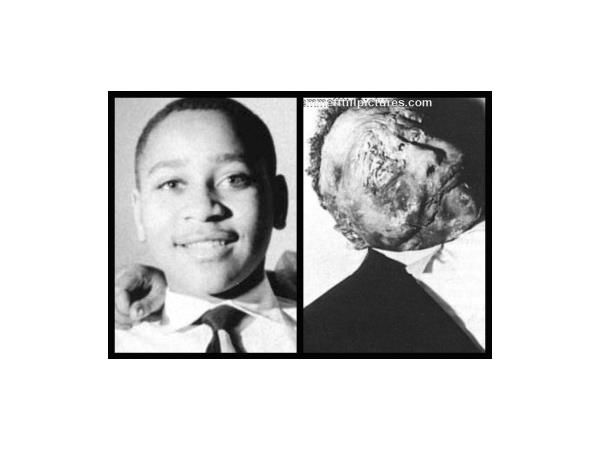
At this point, a cousin ran in, grabbed Bobo and began pulling him out of the store. Carolyn now ran, not for Juanita, but out the front, and got the pistol from the Milam car. Outside, with Bobo being ushered off by his cousins, and with Carolyn getting the gun, Bobo executed the “wolf whistle” which gave the case its name.
That was the sum of the facts on which most newspaper readers based an opinion. The Negroes drove away; and Carolyn, shaken, told Juanita. The two women determined to keep the incident from their “Men-folks.” They didn’t tell J. W. Milam when he came to escort them home. By Thursday afternoon, Carolyn Bryant could see the story was getting around. She spent Thursday night at the Milams, where at 4 a.m. (Friday) Roy got back from Texas. Since he had slept little for five nights, he went to bed at the Milams’ while Carolyn returned to the store. During Friday afternoon, Roy reached the store, and shortly thereafter a Negro told him what “the talk” was, and told him that the “Chicago boy” was “visitin’ Preacher.” Carolyn then told Roy what had happened. Once Roy Bryant knew, in his environment, in the opinion of most white people around him, for him to have done nothing would have marked him for a coward and a fool. On Friday night, he couldn’t do anything. He and Carolyn were alone, and he had no car. Saturday was collection day, their busy day in the store. About 10:30 Saturday night, J. W. Milam drove by. Roy took him aside.
“I want you to come over early in the morning,” he said. “I need a little transportation.”
J.W. protested: “Sunday’s the only morning I can sleep. Can’t we make it around noon?”
Roy then told him.
“I’ll be there,” he said. “Early.”
J. W. drove to another brother’s store at Minter City, where he was working. He closed that store about 12:30 a.m., drove home to Glendora. Juanita was away, visiting her folks at Greenville. J. W. had been thinking. He decided not to go to bed. He pumped the pickup — a half-ton ’55 Chevrolet — full of gas and headed for Money.
J. W. “Big Milam” is 36: six feet two, 235 pounds; an extrovert. Short boots accentuate his height; khaki trousers; red sports shirt; sun helmet. Dark-visaged; his lower lip curls when he chuckles; and though bald, his remaining hair is jet-black.
He is slavery’s plantation overseer. Today, he rents Negro-driven mechanical cotton pickers to plantation owners. Those who know him say that he can handle Negroes better than anybody in the country.
Big Milam soldiered in the Patton manner. With a ninth-grade education, he was commissioned in battle by the 75th Division. He was an expert platoon leader, expert street fighter, expert in night patrol, expert with the “grease gun,” with every device for close range killing. A German bullet tore clear through his chest; his body bears “multiple shrapnel wounds.” Of his medals, he cherishes one: combat infantryman’s badge. Big Milam, like many soldiers, brought home his favorite gun: the .45 Colt automatic pistol.
“Best weapon the Army’s got,” he says. “Either for shootin’ or sluggin’.”
Two hours after Big Milam got the word — the instant minute he could close the store — he was looking for the Chicago Negro.
Big Milam reached Money a few minutes shy of 2 a.m., Sunday, August 28. The Bryants were asleep; the store was dark but for the all-night light. He rapped at the back door, and when Roy came, he said: “Let’s go. Let’s make that trip now.”
Roy dressed, brought a gun: this one was a .45 Colt. Both men were and remained — cold sober. Big Milam had drunk a beer at Minter City around 9; Roy had had nothing.
There was no moon as they drove to Preacher’s house: 2.8 miles east of Money.
Preacher’s house stands 50 feet right of the gravel road, with cedar and persimmon trees in the yard. Big Milam drove the pickup in under the trees. He was bareheaded, carrying a five-cell flashlight in his left hand, the .45 in the right. Roy Bryant pounded on the door.
Preacher: “Who’s that?”
Bryant: “Mr. Bryant from Money, Preacher.”
Preacher: “All right, sir. Just a minute.”
Preacher came out of the screened-in porch.
Bryant: “Preacher, you got a boy from Chicago here?”
Preacher: “Yessir.”
Bryant: “I want to talk to him.”
Preacher: “Yessir. I’ll get him.”
Preacher led them to a back bedroom where four youths were sleeping in two beds. In one was Bobo Till and Simeon Wright, Preacher’s youngest son. Bryant had told Preacher to turn on the lights; Preacher had said they were out of order.So only the flashlight was used. The visit was not a complete surprise. Preacher testified that he had heard of the “trouble,” that he “sho’ had” talked to his nephew about it. Bobo himself had been afraid; he had wanted to go home the day after the incident. The Negro girl in the party urged that he leave. “They’ll kill him,” she had warned. But Preacher’s wife, Elizabeth Wright, had decided that the danger was being magnified; she had urged Bobo to “finish yo’ visit.”
“I thought they might say something to him, but I didn’t think they’d kill a boy,” Preacher said.
Big Milam shined the light in Bobo’s face, said: “You the nigger who did the talking?”
“Yeah,” Bobo replied.
Milam: “Don’t say, ‘Yeah’ to me: I’ll blow your head off. Get your clothes on.”
Bobo had been sleeping in his shorts. He pulled on a shirt and trousers, then reached for his socks.
“Just the shoes,” Milam hurried him.
“I don’t wear shoes without socks,” Bobo said: and he kept the gun-bearers waiting while he put on his socks, then a pair of canvas shoes with thick crepe soles.
Preacher and his wife tried two arguments in the boy’s behalf.
“He ain’t got good sense,” Preacher begged. “He didn’t know what he was doing. Don’t take him.”
“I’ll pay you gentlemen for the damages,” Elizabeth Wright said.
“You niggers go back to sleep,” Milam replied.
They marched him into the yard, told him to get in the back of the pickup and lie down. He obeyed. They drove toward Money.
Elizabeth Wright rushed to the home of a white neighbor, who got up, looked around, but decided he could do nothing. Then, she and Preacher drove to the home of her brother, Crosby Smith, at Sumner; and Crosby Smith, on Sunday morning, went to the sheriff’s office at Greenwood. The other young Negroes stayed at Preacher’s house until daylight, when Wheeler Parker telephoned his mother in Chicago, who in turn notified Bobo’s mother, Mamie Bradley, 33, 6427 S. St. Lawrence. Had there been any doubt as to the identity of the “Chicago boy who done the talking,” Milam and Bryant would have stopped at the store for Carolyn to identify him. But there had been no denial. So they didn’t stop at the store. At Money, they crossed the Tallahatchie River and drove west. Their intention was to “just whip him… and scare some sense into him.” And for this chore, Big Milam knew “the scariest place in the Delta.” He had come upon it last year hunting wild geese. Over close to Rosedale, the Big River bends around under a bluff. “Brother, she’s a 100-foot sheer drop, and she’s a 100 feet deep after you hit.”
Big Milam’s idea was to stand him up there on that bluff, “whip” him with the .45, and then shine the light on down there toward that water and make him think you’re gonna knock him in. “Brother, if that won’t scare the Chicago ——-, hell won’t.”
Searching for this bluff, they drove close to 75 miles. Through Shellmound, Schlater, Doddsville, Ruleville, Cleveland to the intersection south of Rosedale. There they turned south on Mississippi No. 1, toward the entrance to Beulah Lake. They tried several dirt and gravel roads, drove along the levee. Finally, they gave up: in the darkness, Big Milam couldn’t find his bluff. They drove back to Milam’s house at Glendora, and by now it was 5 a.m.. They had been driving nearly three hours, with Milam and Bryant in the cab and Bobo lying in the back.
At some point when the truck slowed down, why hadn’t Bobo jumped and run? He wasn’t tied; nobody was holding him. A partial answer is that those Chevrolet pickups have a wraparound rear window the size of a windshield. Bryant could watch him. But the real answer is the remarkable part of the story.
Bobo wasn’t afraid of them! He was tough as they were. He didn’t think they had the guts to kill him.
Milam: “We were never able to scare him. They had just filled him so full of that poison that he was hopeless.”
Back of Milam’s home is a tool house, with two rooms each about 12 feet square. They took him in there and began “whipping” him, first Milam then Bryant smashing him across the head with those .45’s. Pistol-whipping: a court-martial offense in the Army… but MP’s have been known to do it…. And Milam got information out of German prisoners this way.
But under these blows Bobo never hollered — and he kept making the perfect speeches to insure martyrdom.
Bobo: “You bastards, I’m not afraid of you. I’m as good as you are. I’ve ‘had’ white women. My grandmother was a white woman.”
Milam: “Well, what else could we do? He was hopeless. I’m no bully; I never hurt a nigger in my life. I like niggers — in their place — I know how to work ’em. But I just decided it was time a few people got put on notice. As long as I live and can do anything about it, niggers are gonna stay in their place. Niggers ain’t gonna vote where I live. If they did, they’d control the government. They ain’t gonna go to school with my kids. And when a nigger gets close to mentioning sex with a white woman, he’s tired o’ livin’. I’m likely to kill him. Me and my folks fought for this country, and we got some rights. I stood there in that shed and listened to that nigger throw that poison at me, and I just made up my mind. ‘Chicago boy,’ I said, ‘I’m tired of ’em sending your kind down here to stir up trouble. Goddam you, I’m going to make an example of you — just so everybody can know how me and my folks stand.’”
So Big Milam decided to act. He needed a weight. He tried to think of where he could get an anvil. Then he remembered a gin which had installed new equipment. He had seen two men lifting a discarded fan, a metal fan three feet high and circular, used in ginning cotton.
Bobo wasn’t bleeding much. Pistol-whipping bruises more than it cuts. They ordered him back in the truck and headed west again. They passed through Doddsville, went into the Progressive Ginning Company. This gin is 3.4 miles east of Boyle: Boyle is two miles south of Cleveland. The road to this gin turns left off U.S. 61, after you cross the bayou bridge south of Boyle.
Milam: “When we got to that gin, it was daylight, and I was worried for the first time. Somebody might see us and accuse us of stealing the fan.”
Bryant and Big Milam stood aside while Bobo loaded the fan. Weight: 74 pounds. The youth still thought they were bluffing.
They drove back to Glendora, then north toward Swan Lake and crossed the “new bridge” over the Tallahatchie. At the east end of this bridge, they turned right, along a dirt road which parallels the river. After about two miles, they crossed the property of L.W. Boyce, passing near his house.
About 1.5 miles southeast of the Boyce home is a lonely spot where Big Milam has hunted squirrels. The river bank is steep. The truck stopped 30 yards from the water. Big Milam ordered Bobo to pick up the fan. He staggered under its weight… carried it to the river bank. They stood silently… just hating one another.
Milam: “Take off your clothes.”
Slowly, Bobo pulled off his shoes, his socks. He stood up, unbuttoned his shirt, dropped his pants, his shorts.
He stood there naked. It was Sunday morning, a little before 7.
Milam: “You still as good as I am?”
Bobo: “Yeah.”
Milam: “You still ‘had’ white women?”
Bobo: “Yeah.”
That big .45 jumped in Big Milam’s hand. The youth turned to catch that big, expanding bullet at his right ear. He dropped.
They barb-wired the gin fan to his neck, rolled him into 20 feet of water.
For three hours that morning, there was a fire in Big Milam’s back yard: Bobo’s crepe soled shoes were hard to burn.
Seventy-two hours later — eight miles downstream — boys were fishing. They saw feet sticking out of the water. Bobo.
The majority — by no means all, but the majority — of the white people in Mississippi 1) either approve Big Milam’s action or else 2) they don’t disapprove enough to risk giving their “enemies” the satisfaction of a conviction.
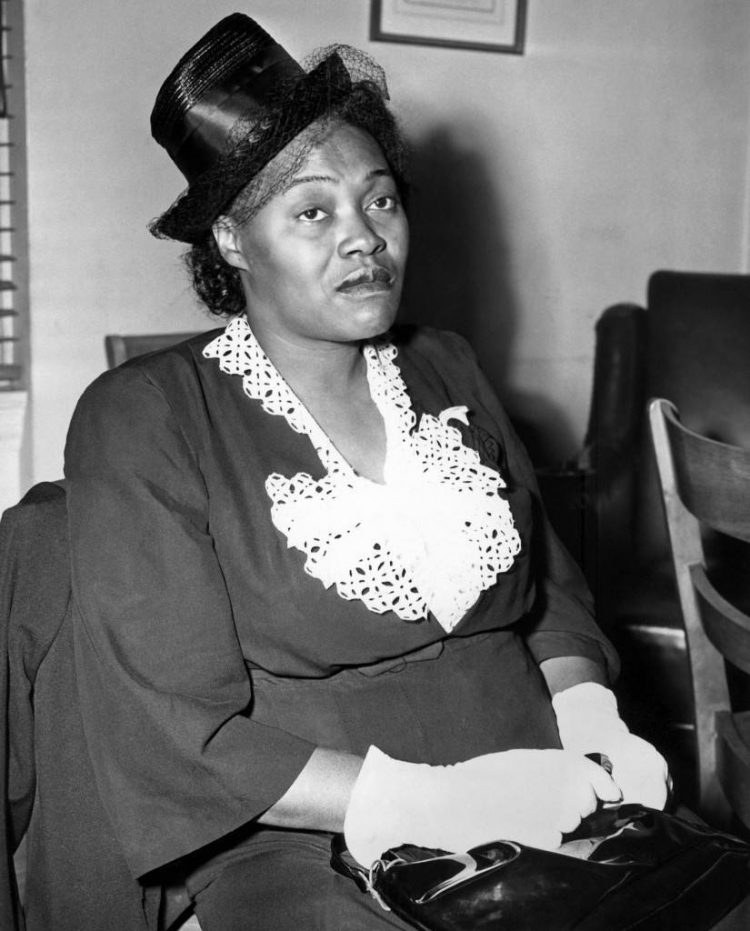
Tessie Earle, 38-year-old mother of Willie Earle, Greenville, South Carolina, lynch victim, appears at a press conference in New York, May 25, 1947. The National Negro Day Committee arranged and financed the trip for Mrs. Earle from Greenville to New York so that she could appear on May 27 in Madison Square Garden at a program sponsored by the committee. (AP Photo/Julian C. Wilson)
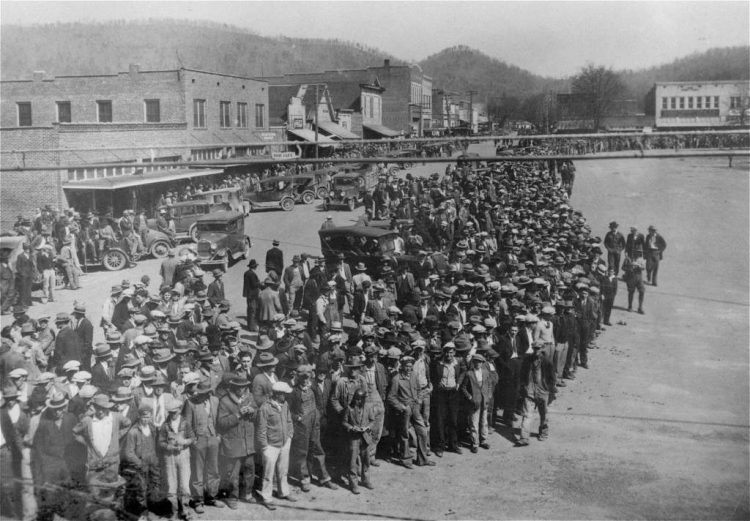
Here is shown a part of the crowd of 10,000 persons who jammed the courthouse square in the little town of Scottsboro, Alabama, April 6, 1933, on the opening of the trials of nine black youths accused of attacking two white girls near Sevenson, Ala., March 24, 1931. National Guardsmen with fixed bayonets patrolled the courthouse grounds, and women and minors were barred from the courtroom. The state asked for the death penalty for the first two defendants to be placed on trial. The other seven will be tried later. The nine were identified by the two girls as the ones who boarded the freight car in which they and seven white youths were riding, forced five of the white youths from the train, knocked the other two unconscious and attacked the girls.
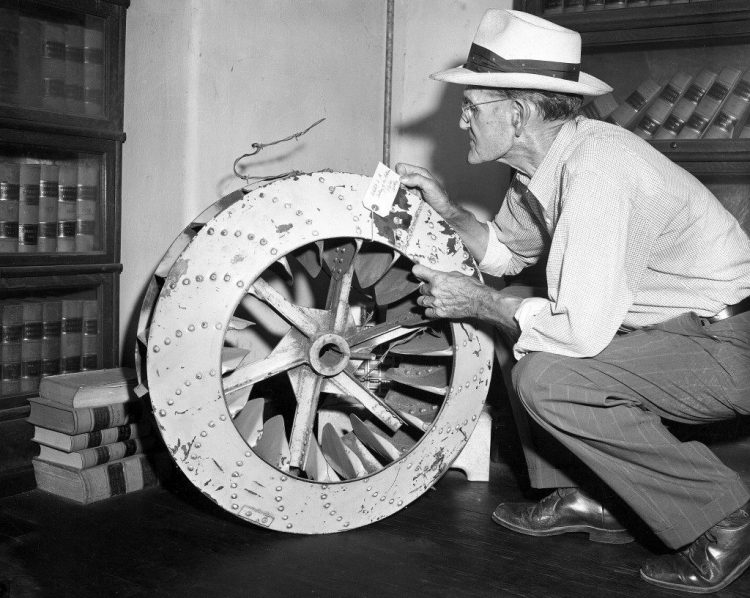
A cotton-gin fan is presented as evidence in the trial investigating the death of 14-year-old Chicago boy Emmett Louis Till, in Sumner, Miss., on September 22, 1955. The fan had been tied around the boy’s neck with barbed wire when his body was found in the Tallahatchie River near the Delta community of Money, Mississippi, on August 31, 1955. (AP Photo)
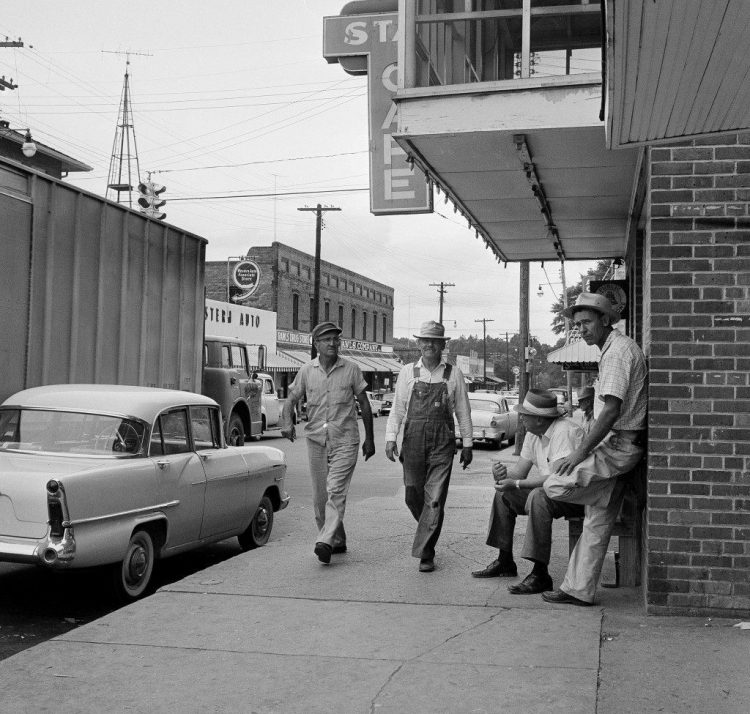
This street scene in Poplarville, Miss., looks like it could be a copy of many Main Streets in many southern U.S. towns, shown June 3, 1959. But the community is troubled in the wake of the lynching of Charles Mack Parker, 23-year-old black man, who was dragged from jail April 24. He had been charged with raping a pregnant white woman. The general feeling among townspeople – at least what has been expressed – is the hope that authorities never catch the men who lynched Parker. This feeling was heightened during the FBI investigation of the case. (AP Photo)
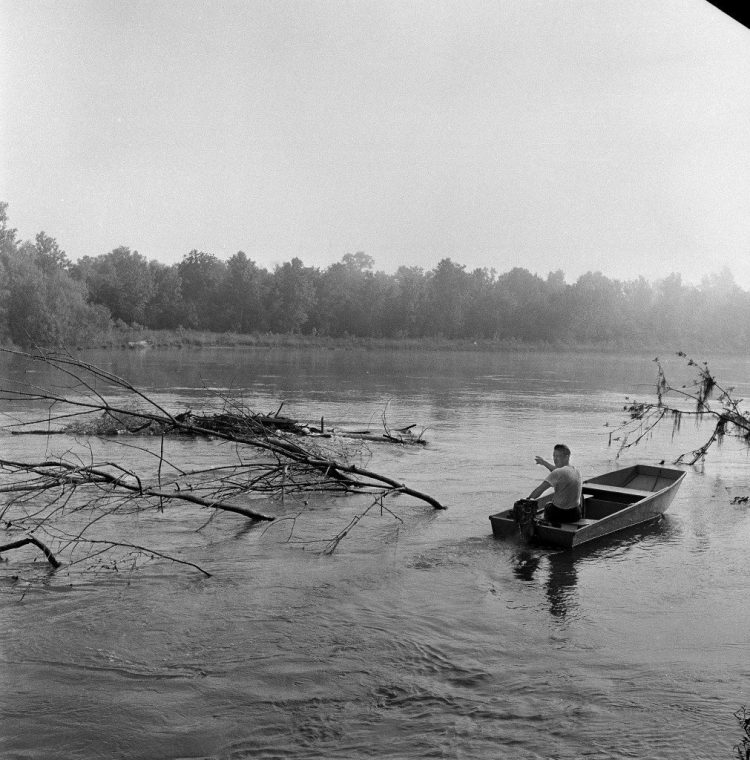
The clog of debris in the Pearl River where the body of Mack Charles Parker was discovered, is pointed out by Al Wheat, 39-year-old fisherman, near Poplarville, Miss., May 5, 1959. Wheat, who aided the recovery of the body with his small boat, points to the outermost clump, at left. Swampy terrain made recovery by boat necessary. Parker’s body was found about two miles south of a bridge connecting the highway between Bogalusa, La., and Poplarville. It was on the Mississippi side of the river which separates the states about 20 mile west of here. (AP Photo/Richard Tolbert)
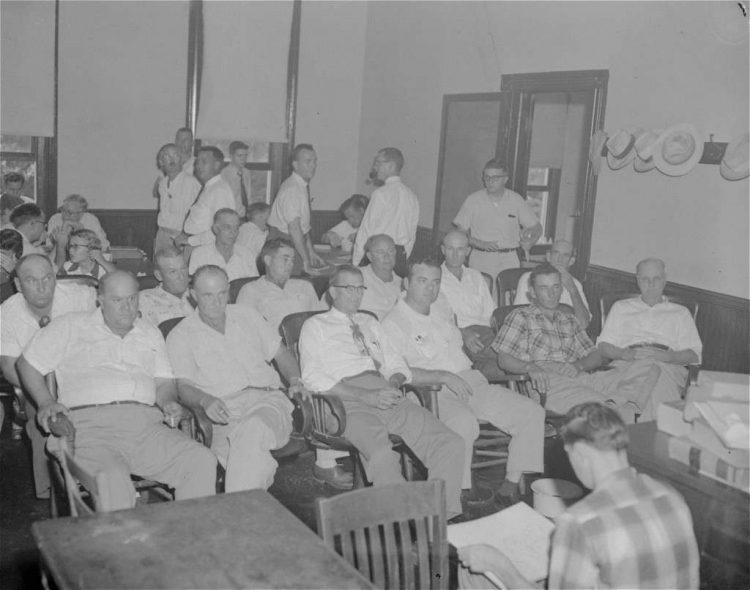
These 12 men were seated September 20, 1955 in the jury box to hear testimony and decide the fate of Roy Bryant and J.W. Milam, who are charged with slaying Emmett Louis Till. Left to right, in front row, are Gus Ramsey, James Toole, E.L. Price, J.A. Shaw, Jr., Ray Tribble, and Ed Devaney. Back row, Travis Thomas, George Holland, Jim Pennington, Davis Newton, Howard Armstrong, and Bishop Matthews. The alternate juror is not pictured. (AP Photo/stf)
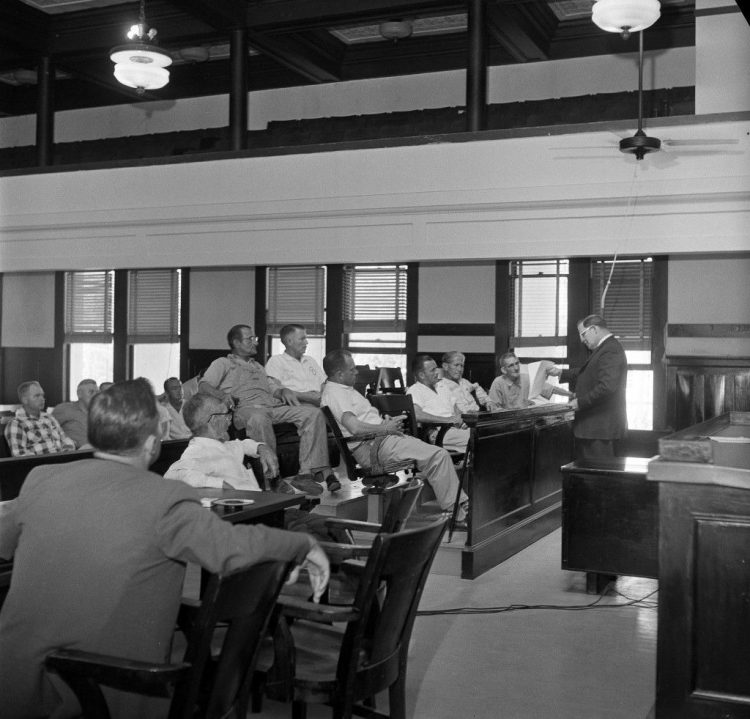
A six-member jury at a coroner’s inquest into the lynch mob death of Mack Charles Parker, a 23-year-old African-American accused of rape, hears County Attorney William Steward, right, read the autopsy report, in Poplarville, Miss., May 5, 1959. Justice of the Peace Walter Davis, who conducted the hearing, sits left, foreground. Parker’s body was found in the Pearl River yesterday. The jury ruled he died from “two high speed projectiles,” probably bullet wounds, inflicted by an unknown person or persons. District Attorney Vernon Broom can be seen on the extreme left, with his back to the camera. (AP Photo/Richard Tolbert)
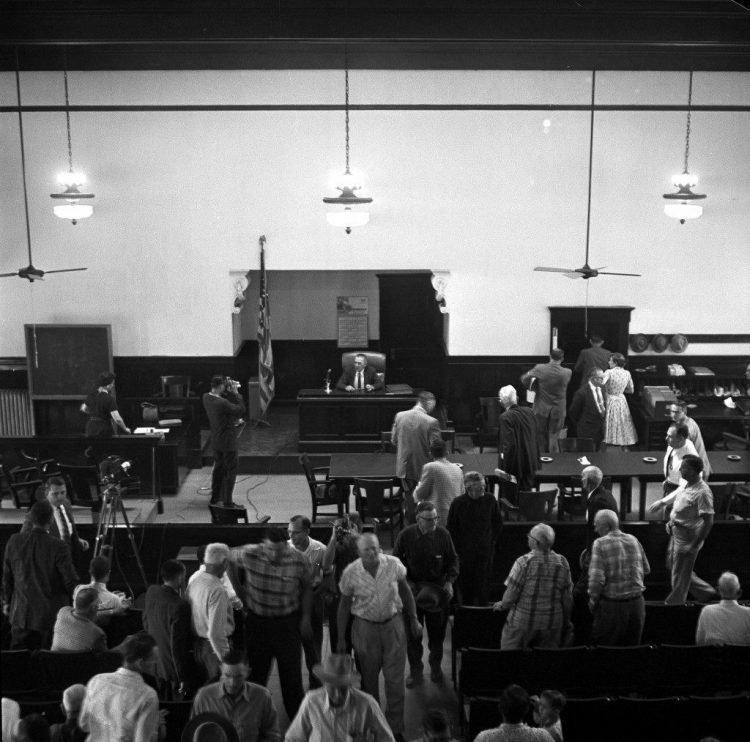
Part of a dismissed jury panel, foreground, leaves Pearl River County circuit court after Judge Sebe Dale, still at bench, top left, excused them and condemned the abduction and lynching of Mack Charles Parker, 23, an African-American charged with raping a white woman, in Poplarville, Miss., April 27, 1959. Masked men removed him from jail on Saturday. Neither Parker, or his abductors have been found. Judge Dale canceled all cases until the May term. He said the abduction denied Parker a fair trial. (AP Photo/Richard Tolbert)
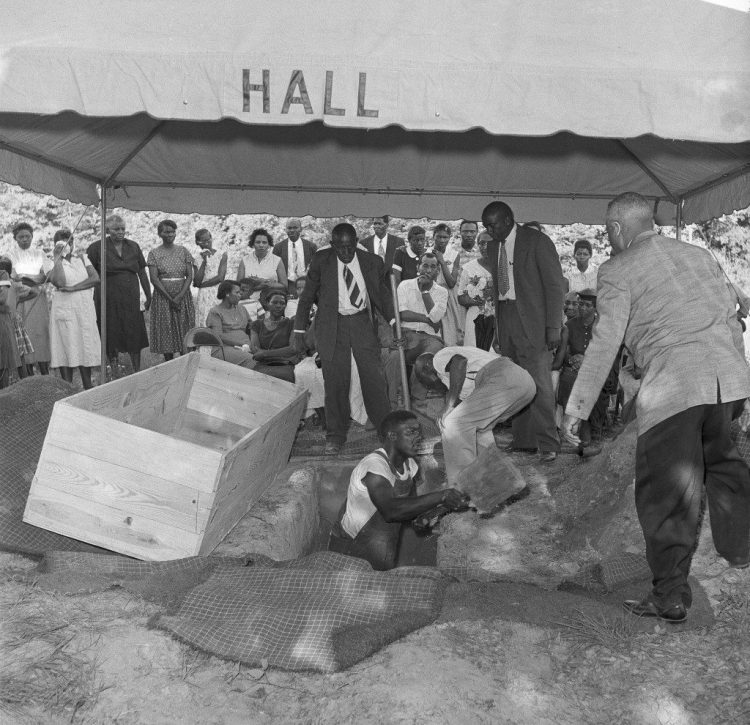
A gravedigger delays the burial service for Mack Charles Parker, 23-year-old African-American man accused of rape, to widen the grave for the pine box, left, in Lumberton, Miss., May 5, 1959. Grief is written on the faces of relatives and friends of Parker, who was the victim of a lynch mob. Parker’s body was retrieved from the Pearl River the previous day. About 100 African-Americans and 20 newsmen witnessed the burial. (AP photo/Richard Tolbert) 1959.
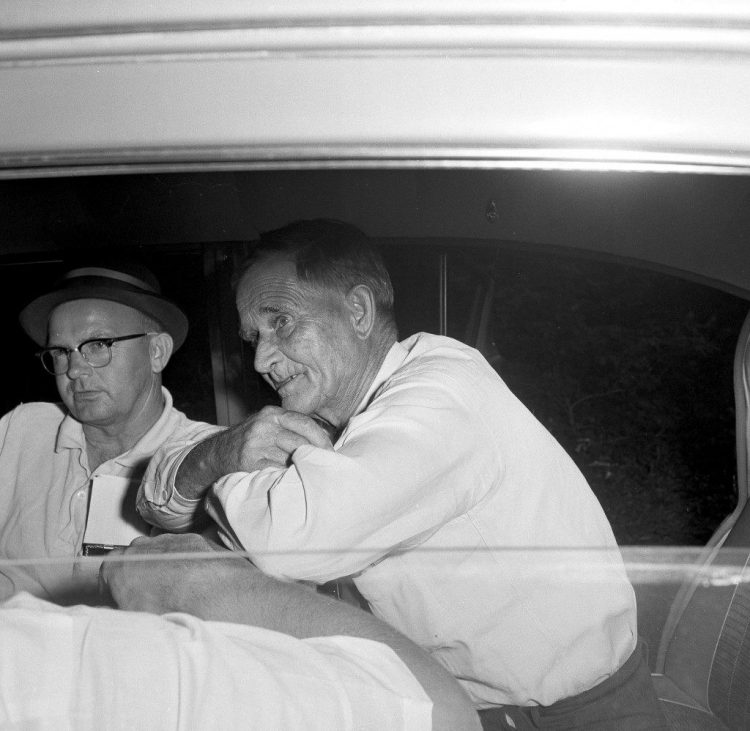
John Reyer, right, a 63-year-old local farmer,sits in the rear of an FBI car telling agents how he witnessed the abduction of Mack Charles Parker from his jail cell, in Poplarville, Miss., April 26, 1959. Reyer told them he saw four masked men throw an African-American man into the back seat of a car and drive off. Reyer had been visiting the hospital across the street. Parker was being held on the charge of raping a white woman. The trial was scheduled to start in two days.
(AP Photo/Richard Tolbert)
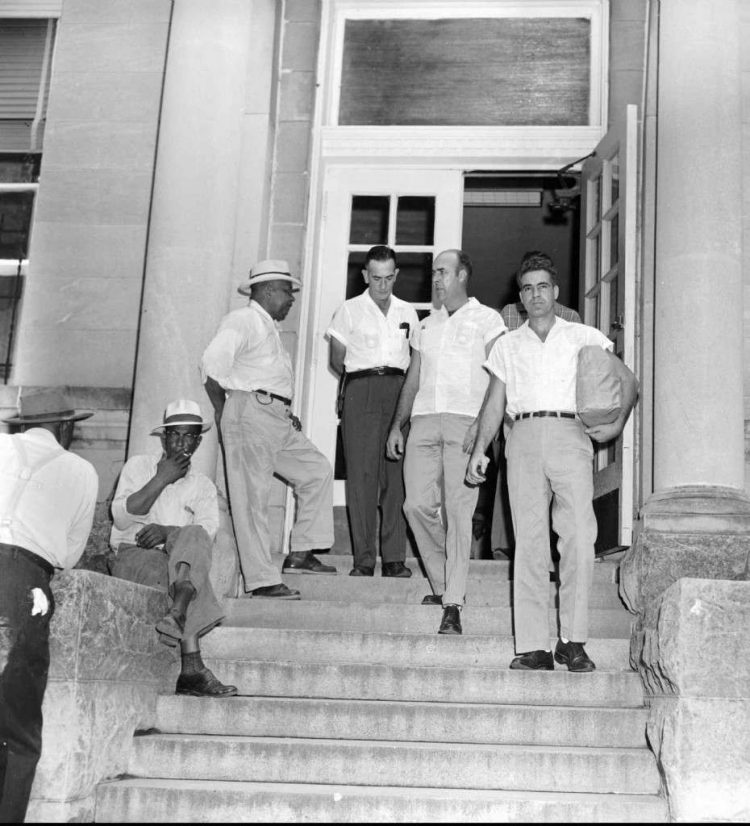
Roy Bryant, right, and his half-brother, J. W. Milam, second from right, walk down the steps of the Leflore County Courthouse in Greenwood, Miss., on Sept. 30, 1955, after being freed on bond in the kidnapping and murder of Emmett Till. Bryant and Milam eventually were acquitted of murdering the 14-year-old black youth in a trial which drew international attention that fall. (AP Photo)
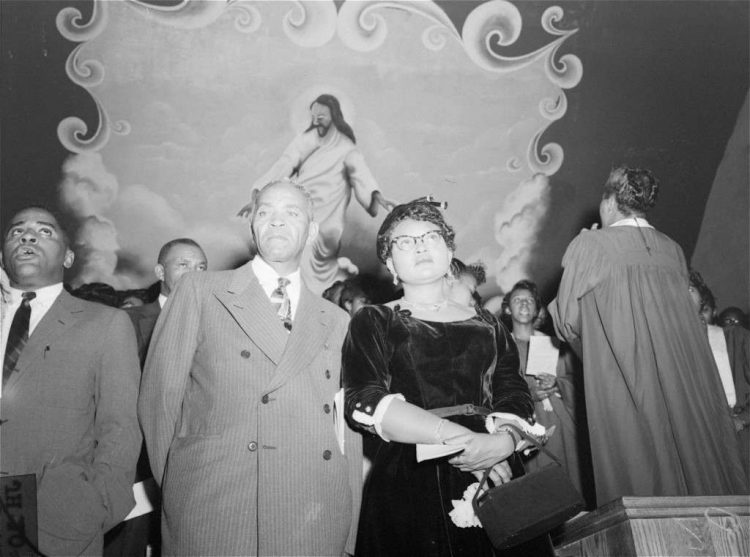
Mrs. Mamie Bradley, mother of Emmett Louis Till, a black 14 year old slain in Mississippi, attends a rally in Williams Institutional Christian Methodist Episcopal Church at Seventh Avenue, between 131st and 132nd Streets, New York City, September 25, 1955, at which the verdict of last week’s trial at Sumner, MS was denounced. Mrs. Bradley told the rally that the acquittal of the two men accused of the murder of her son constituted a signal that lynching is now in order. (AP Photo/stf)
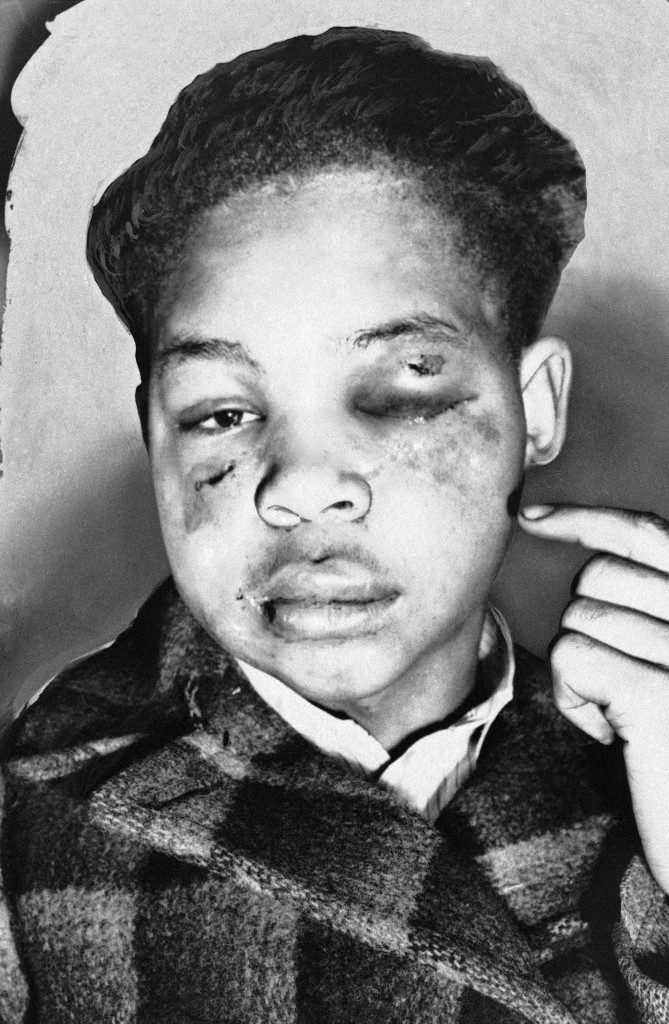
Lamar Howard, 19, of Monroe, Ga., points to bruises he said he received in Atlanta from two white men, Jan. 2, 1947. Howard said they tried to force from him his testimony before a federal grand jury investigation the lynching of four blacks near Monroe last summer. (AP Photo)
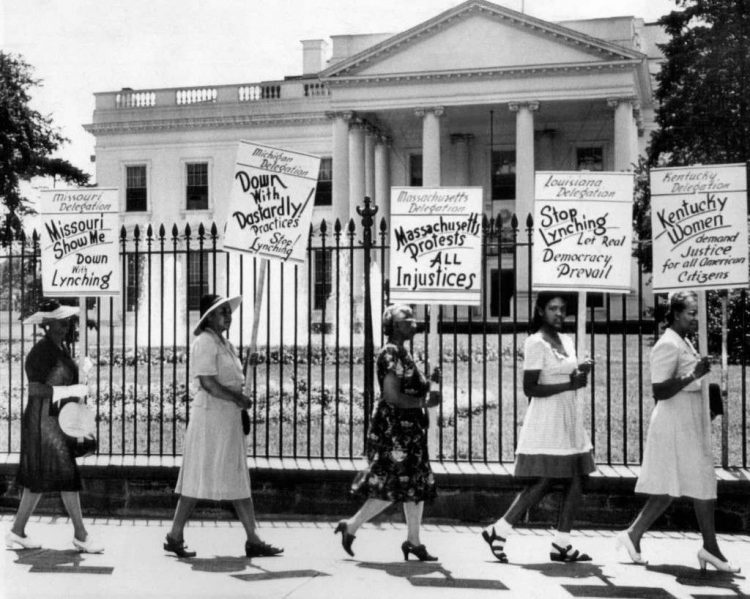
Pickets, representing the National Association of Colored Women, march at the White House, Washington, July 30, 1946, carrying posters protesting lynching. Placards bear names of Missouri, Michigan, Massachusetts, Louisiana and Kentucky delegations. (AP Photo)
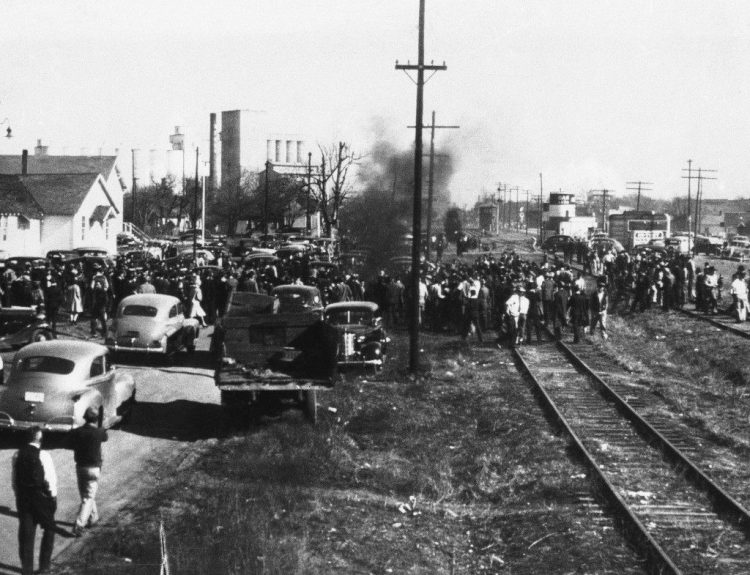
Smoke rises from the burning body of Cleo Wright, African American, suspected of attempted rape of a white woman. He was taken from the city hall of Sikeston, Missouri on Jan. 25, 1942, already injured by an arresting officer, and was burned by a mob. (AP Photo)
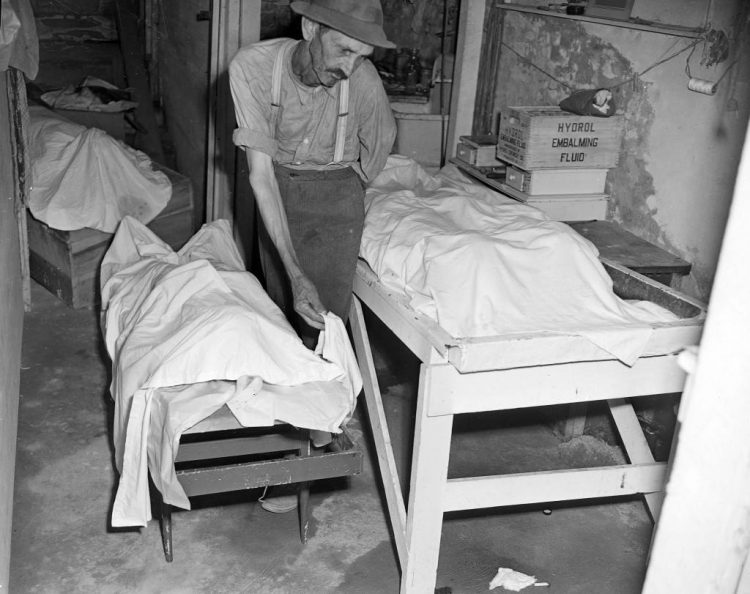
Coroner W.T Brown places a sheet over the body of one of four African American mob victims in a funeral home at Monroe, Ga., in a July 26, 1946 file photo. Newly released files from the lynching of two black couples more than 60 years ago contain a disturbing revelation: The FBI investigated suspicions that a three-term governor of Georgia sanctioned the murders to sway rural white voters during a tough election campaign. (AP Photo, File)
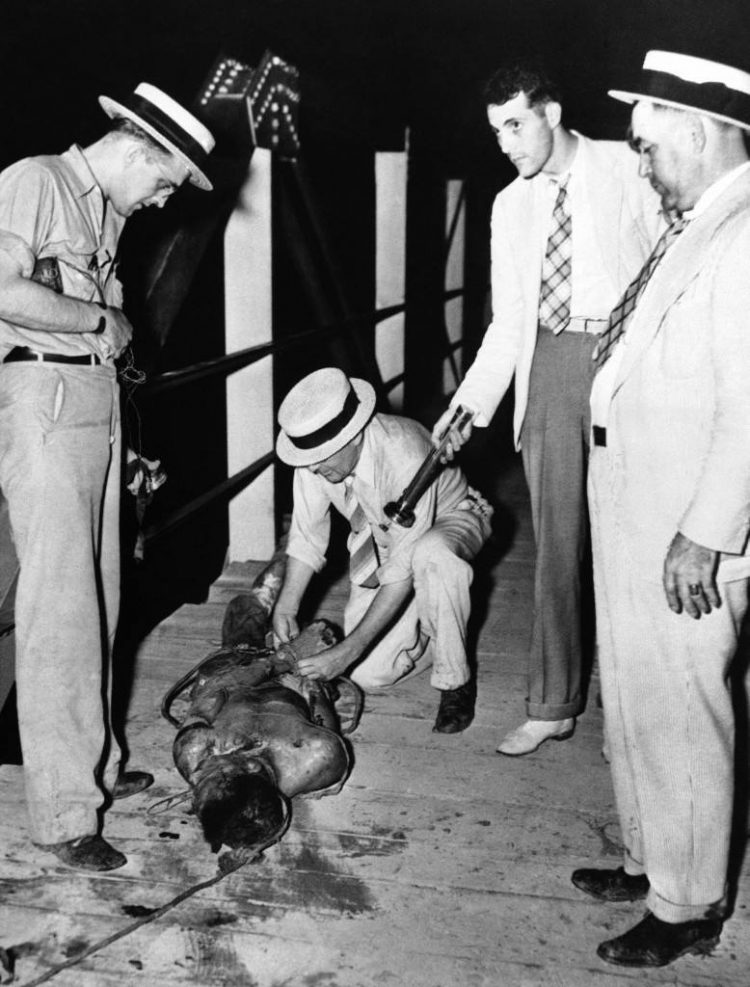 Weary searchers found the bullet-riddled body of Albert Gooden, 35-year-old African American, Tipton CountyÂ’s first lynch victim since the Civil War near Covington, Tennessee on August 17, 1937. Gooden was seized from Sheriff W.J. Vaughan the night before while the officer was en route from Memphis, where Gooden was held for safekeeping, to Covington, where he was to face a charge a slaying an officer. (AP Photo)
Weary searchers found the bullet-riddled body of Albert Gooden, 35-year-old African American, Tipton CountyÂ’s first lynch victim since the Civil War near Covington, Tennessee on August 17, 1937. Gooden was seized from Sheriff W.J. Vaughan the night before while the officer was en route from Memphis, where Gooden was held for safekeeping, to Covington, where he was to face a charge a slaying an officer. (AP Photo)
Saved earlier from a mob by national guardsmen and a judge, Lint Shaw, a 45 year old Negro, was taken from jail in Royston, Georgia, and lynched a short time before he was to have gone on trial for attacking a white girl.
Ref #: PA.2480685
Date: 28/04/1936
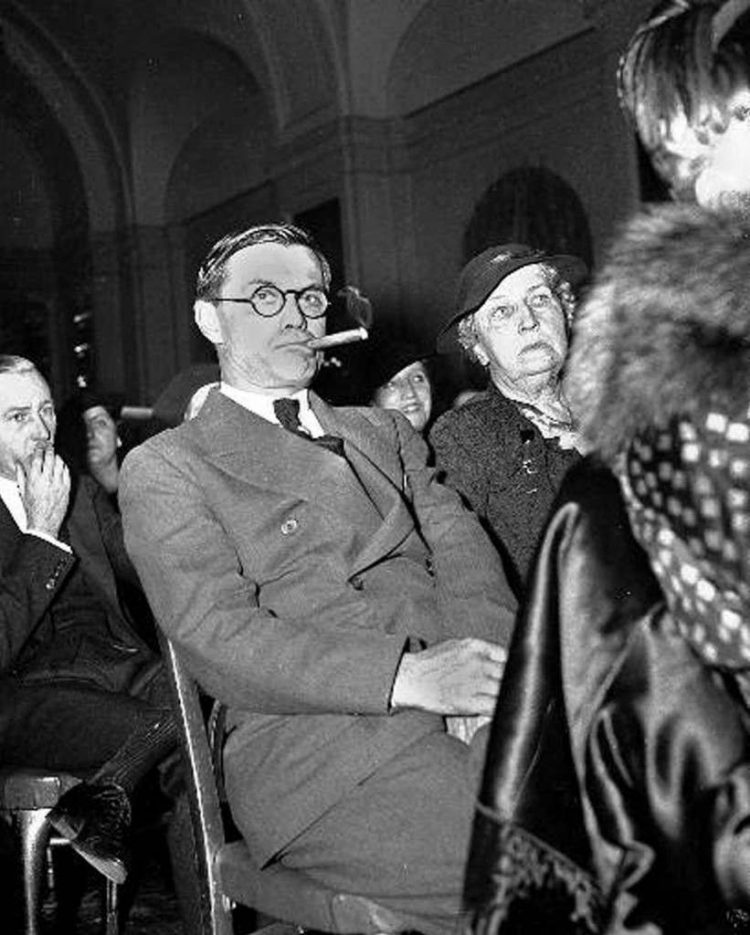
Georgia Governor Eugene Talmadge bites his cigar at a Democratic National Committee meeting in Washington, D.C., in a Jan. 9, 1936 file photo. Newly released files from a horrific lynching of two black couples 61 years ago contain a disturbing revelation: The FBI investigated suspicions that Talmadge, a three-term governor of Georgia, approved the murders to sway rural white voters during a tough election campaign. (AP Photo, File)
A crowd gathers to view the body of 32-year-old Rubin Stacy as he hangs from a tree in Fort Lauderdale, Fl., on July 19, 1935. Stacy was lynched by a mob of masked men who seized him from the custody of sheriff’s deputies for allegedly attacking a white woman.
Ref #: PA.2499602
The body of 32-year-old Rubin Stacy hangs from a tree in Fort Lauderdale, Fla., as neighbors visit the site.
Stacy was lynched by a mob of masked men who seized him from the custody of sheriff’s deputies for allegedly attacking a white woman.
Ref #: PA.2480694
Date: 19/07/1935
More than 1,200 braved disagreeable weather to attend a rally in Union Square, New York City, December 9, 1933, on behalf of the nine Scottsboro boys. The meeting was arranged by the International Labor Defense and was backed by the Communist Party. The marchers carried banners and a sign with the image of a lynching, and the legend “Alabama – The land of the tree and the home of the grave.”
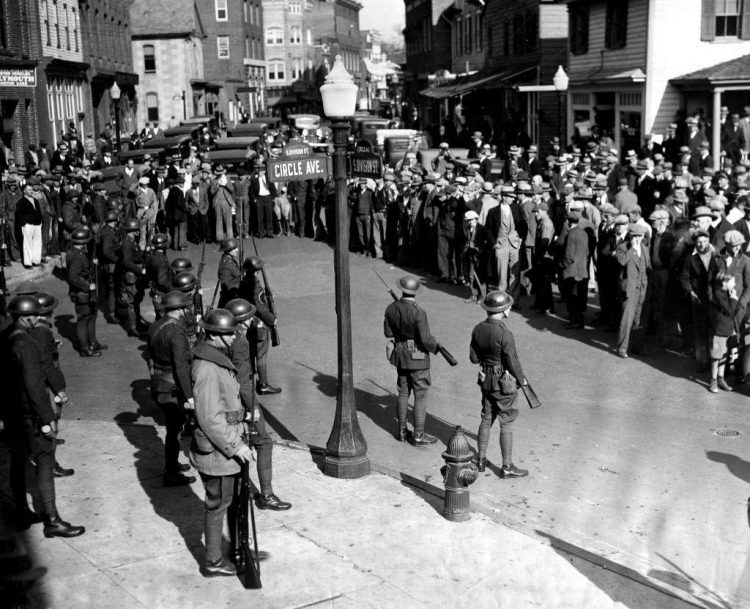
State Troopers keep a crowd in check in Salisbury, Md., Nov. 28, 1933. The troopers were sent by Gov. Albert Ritchie to arrest suspects in the lynching of George Armwood in nearby Princess Anne, Md., last month. They were threatened by the crowds and used tear gas to repulse them. (AP Photo)
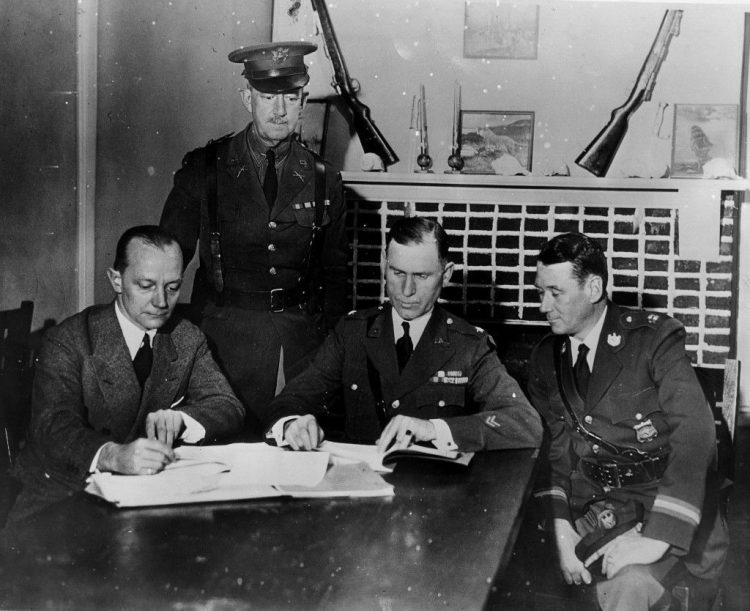
Maryland State Troopers in charge of the campaign to apprehend a group of lynchers work out a plan of attack in Salisbury, Md., Nov. 28, 1933. From left: Attorney General W. Preston Lane Jr.; Col. Washington Bowie; Brigadier General Milton A. Reckord, state adjutant general; and Capt. Edward Mck. Johnson of the Maryland State Police. (AP Photo)
Ref #: PA.20299308
Date: 28/11/1933
Rioter’s converge outside the Douglas County Courthouse. On Sept. 27, an angry mob grabbed William Brown, a black man, inside the courthouse after he was accused of mugging a white, handicapped man and raping the man’s fiancee. Brown was stripped, beaten unconscious and castrated before hundreds of bullets were fired into his body as he was dragged by an automobile and hanged from a downtown light pole.
Ref #: PA.2499598
Date: 28/09/1919
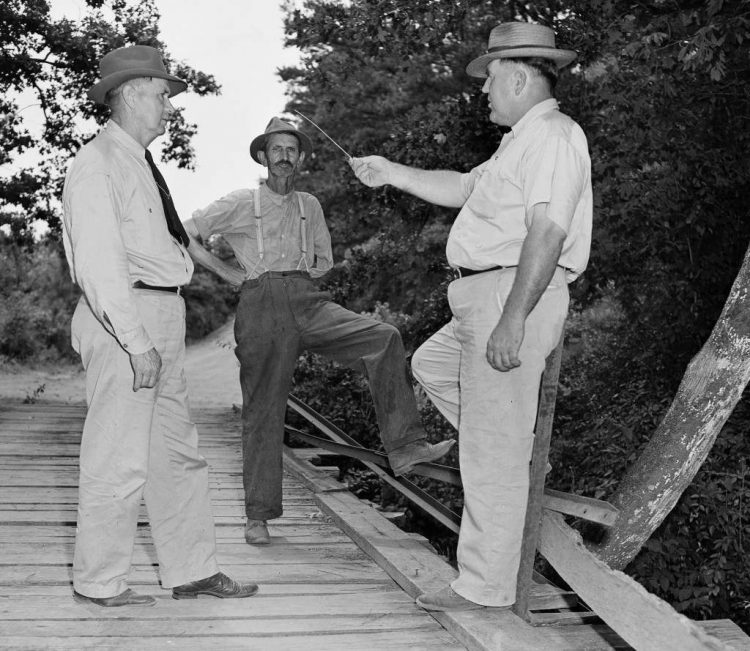
Loy Harrison, right, in this photo taken July 26, 1946, shows Oconeee County Sheriff J.M. Bond, left, and Coroner W.T. Brown of Walton County, center, the spot where four blacks had been abducted from his car. On July 25, 1946 George Dorsey, Mae Murray Dorsey, Roger Malcom and Dorothy Malcom were lynched by a mob on the old bridge that spanned the Apalachee River some 60 miles from Atlanta.
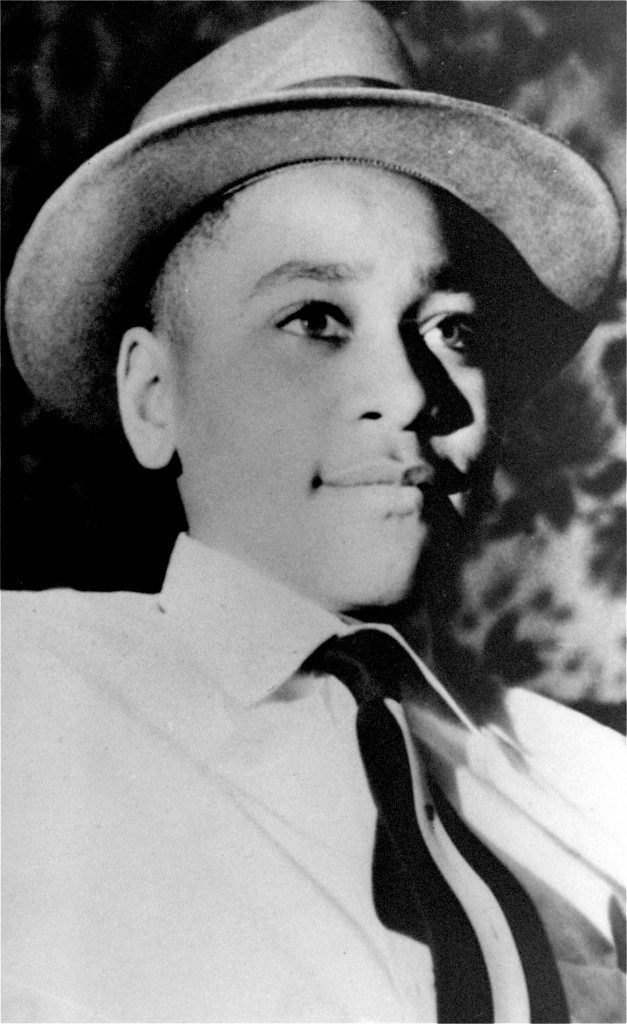
An undated portrait of Emmett Louis Till, a black 14 year old Chicago boy, whose weighted down body was found in the Tallahatchie River near the Delta community of Money, Mississippi, August 31, 1955. Local residents Roy Bryant, 24, and J.W. Milam, 35, were accused of kidnapping, torturing and murdering Till for allegedly whistling at Bryant’s wife. (AP Photo)





